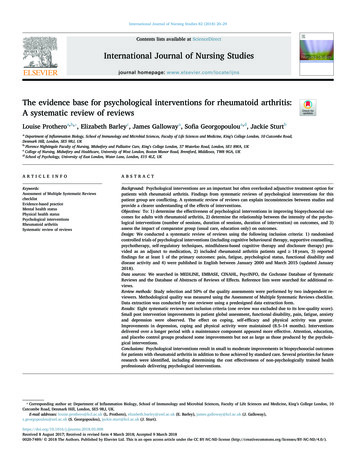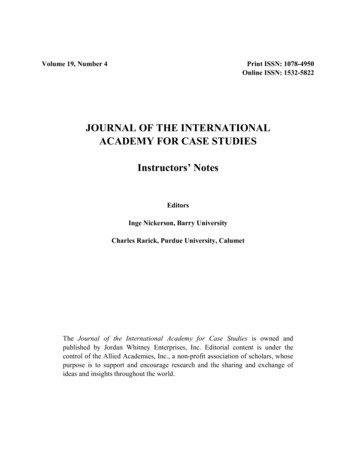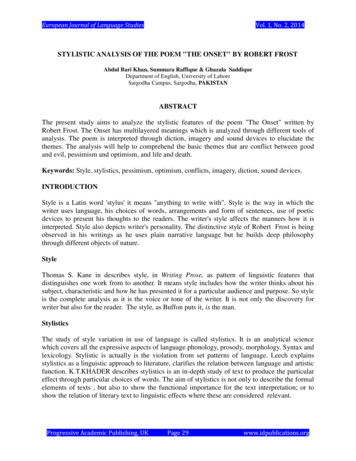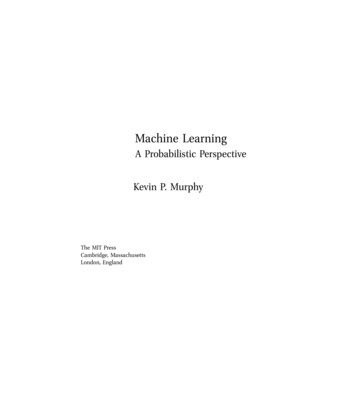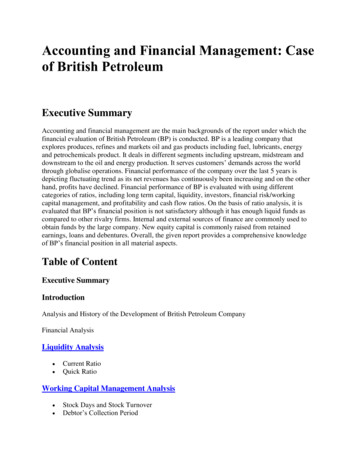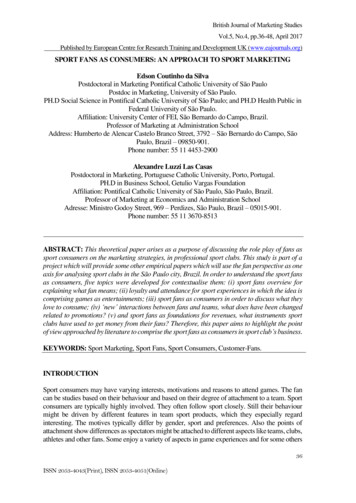
Transcription
British Journal of Marketing StudiesVol.5, No.4, pp.36-48, April 2017Published by European Centre for Research Training and Development UK (www.eajournals.org)SPORT FANS AS CONSUMERS: AN APPROACH TO SPORT MARKETINGEdson Coutinho da SilvaPostdoctoral in Marketing Pontifical Catholic University of São PauloPostdoc in Marketing, University of São Paulo.PH.D Social Science in Pontifical Catholic University of São Paulo; and PH.D Health Public inFederal University of São Paulo.Affiliation: University Center of FEI, São Bernardo do Campo, Brazil.Professor of Marketing at Administration SchoolAddress: Humberto de Alencar Castelo Branco Street, 3792 – São Bernardo do Campo, SãoPaulo, Brazil – 09850-901.Phone number: 55 11 4453-2900Alexandre Luzzi Las CasasPostdoctoral in Marketing, Portuguese Catholic University, Porto, Portugal.PH.D in Business School, Getulio Vargas FoundationAffiliation: Pontifical Catholic University of São Paulo, São Paulo, Brazil.Professor of Marketing at Economics and Administration SchoolAdresse: Ministro Godoy Street, 969 – Perdizes, São Paulo, Brazil – 05015-901.Phone number: 55 11 3670-8513ABSTRACT: This theoretical paper arises as a purpose of discussing the role play of fans assport consumers on the marketing strategies, in professional sport clubs. This study is part of aproject which will provide some other empirical papers which will use the fan perspective as oneaxis for analysing sport clubs in the São Paulo city, Brazil. In order to understand the sport fansas consumers, five topics were developed for contextualise them: (i) sport fans overview forexplaining what fan means; (ii) loyalty and attendance for sport experiences in which the idea iscomprising games as entertainments; (iii) sport fans as consumers in order to discuss what theylove to consume; (iv) ‘new’ interactions between fans and teams, what does have been changedrelated to promotions? (v) and sport fans as foundations for revenues, what instruments sportclubs have used to get money from their fans? Therefore, this paper aims to highlight the pointof view approached by literature to comprise the sport fans as consumers in sport club’s business.KEYWORDS: Sport Marketing, Sport Fans, Sport Consumers, Customer-Fans.INTRODUCTIONSport consumers may have varying interests, motivations and reasons to attend games. The fancan be studies based on their behaviour and based on their degree of attachment to a team. Sportconsumers are typically highly involved. They often follow sport closely. Still their behaviourmight be driven by different features in team sport products, which they especially regardinteresting. The motives typically differ by gender, sport and preferences. Also the points ofattachment show differences as spectators might be attached to different aspects like teams, clubs,athletes and other fans. Some enjoy a variety of aspects in game experiences and for some others36ISSN 2053-4043(Print), ISSN 2053-4051(Online)
British Journal of Marketing StudiesVol.5, No.4, pp.36-48, April 2017Published by European Centre for Research Training and Development UK (www.eajournals.org)a particular club has a great importance (Yoshida & James, 2010). Sport teams bring togetherpeople with varying socioeconomic backgrounds, who share a bond – an attachment to the team.Many fans appreciate that sport provides them an escape from everyday life. Thus, sport fans area heterogeneous group and their range varies from casual fans to committed season ticket holders.This consumer group can be regarded as the most essential in the business of sport club.Popularity of the product attracts other target audiences. In summary, without fans there wouldbe no demand to show games on tv and pay for those rights. In fact, without game-attending fansclubs would have problems attracting sponsor. The initial driver for a sport club’s growth is thedevelopment of a fan-base (The Future of Sports, 2015).In the meantime, across the world, it is seeing ever closer convergence between the sport andentertainment, as both sectors continue to rise to the challenges of new digital technologies whichshape the way individuals may spend their leisure time. At the same time sponsorships and mediarights emerge as the main engines of growth, putting the traditional dominance of gate revenuesunder pressure. Sport clubs are accused of charging more for tickets than providing entertainmentin quality level to fans and spectators who pay for it. The same ultimately applies to the cost ofmedia rights, which can knock on to the pay TV subscriptions funded by fan’s subscribers. Thebalance between price and value proposition is further complicated by the deep sense ofownership that many sports fans feel for their club or sport (Clark, 2011; Collignon & Sultan,2014; KPMG Reports, 2014). In addition, Maltese & Danglade (2014) argument that it'sreflecting trends in entertainment such as brand and product placement, sport sponsors want tobe embedded within the product, rather than just being a name on a shirt. As for fans retain astrong desire to be part of the live experience of supporting their teams. Thereby, this paper aimsto discuss the role play of a fan, as a sport consumer, on the marketing strategies, in professionalsport clubs.SPORT FANS OVERVIEWFan is defined as the person who thinks, talks about and is oriented towards sports even when –the fan – is not actually observing, or reading, or listening to an account of a specific sport event(Norris, Wann & Zapalac (2014). However, fan has also been defined as an affiliation in whicha great deal of emotional significance and value are derived from group membership. In addition,a sport fan as one who shows consistency, dedication and loyalty with the commitment comingin three forms (Stewart, Smith & Nicholson, 2003; Johnston, 2004): (i) cognitive, as the consumerbuilds up knowledge about the sport and team; (ii) attitudinal, as the consumer believes stronglyin the team and the sport; (iii) and behaviourally, showing his/her commitment through tangibleacts such ticket or merchandise purchasing. Thus, fan are individuals who are deeply committedto the club, ergo, this commitment manifests itself in long term affiliation with one team (or club),in significant time and money expenditure, and in loyalty despite results, that is, commitmentpersists even when clubs are not performing well. According to Leal & Moutinho (2008), underthis circumstance, several terms arise in defining and describing a sports fan, for instance, fanatic,passionate partisan, highly committed fan, vested fan, diehard fan and varying definitionssupplied, this sampling of conceptualisations shows the range of definitions as well as thesimilarities and overlap.For this reason, it is advisable established a distinction between mere spectators and fans.Spectators are individuals will observe a sport and then forget about it, while fans will have more37ISSN 2053-4043(Print), ISSN 2053-4051(Online)
British Journal of Marketing StudiesVol.5, No.4, pp.36-48, April 2017Published by European Centre for Research Training and Development UK (www.eajournals.org)intensity and will devote part of every day to the team or the sport itself. However, the differencebetween a fan and a spectator lies in differing levels of passion. But, the differences between afan and a spectator as well as the differences between highly and lowly identified fans. Then,sport fans are identified as individuals who are interested in and follow a sport, team and/orathlete, instead spectators are identified as individuals who actively witness a sporting event inperson or through some form of media, such as radio, television, internet, etc. Spectators remainpassive in their interaction with the game, they watch, analyse and appreciate, and sport fansparticipate in a different way. Sports fans create and shape the experience of sports, consequently,they are not passive receptors, but active parts of the game itself. They influence action on thefield of play, true fans participate in the sports. Fans desperately impart emotional energy, supportand distraction, whenever they can (Stewart, Smith & Nicholson, 2003; Johnston, 2004).Thereby, being a sports fan is an active and lived experience. Fans discussing about their role,because they are not just spectators, they take part in the game and believe that their presence,engagement and involvement impact on their team’s performance (Yoshida & James, 2010). Bythe large, four characteristics define the fans’ profile (Mahony, Madrigal, & Howard, 2000;Johnston, 2004; Piipponen, 2011): (i) emotion: the fan involvement and identification with teamsmay often reach levels where individuals mood and emotions are influenced by team results; (ii)intolerance: some fans are particularly intolerant to other supporters who are not as committed tothe cause as they are. For some fans, ordinary supporters are intruders and they complain thatBritish teams from Premier League are focusing on their strategies to attract the suburban middleclass kids and their parents, first they support teams whether winning or losing, and they producemore money; (iii) supportive social contexts: sport fanatics manifesting in how they choose theirfriends, in the media they consume and the things they collect; (iv) memorabilia: fans have thetendency to collect various team and match related important objects. These phenomenon andterms is known as “capital collecting”. Capital can include just about anything that can becollected – or bought – that represents the team or the sport, for example, books, records, clothes,posters, articles, autographs, photos, video of old performances, newspaper clippings, matchprograms, etc. Fans conserve the precious relics of their attendance, witnesses to the presencenext their idols.Therefore, the term ‘fan’, often popularly used and derived from the word ‘fanatic’, to describeindividuals who willingly invest resources – either emotional and financial – in supporting theirfavourite sport team or club. According to Giulianotti (2002) and Leal & Moutinho (2008), fansdo not represent mere spectators, but rather a fraternity of people who diligently and overprolonged period of time display their allegiance to a specific sport team of which they are ferventsupporters. These individuals often subscribe to the unique culture or ethos of a club, immersethemselves within a community of other fans who share their passion for the club and loyaltyembark on various endeavours that promote club interests, such as attending live matches at thestadium or purchasing the branded merchandise of the club. Sport fans of a particular team formthe essence of what can be described as such club’s collective currency in society. Funk (2008)highlights which this community of people represents the club as ambassadors, generatesawareness of the club in the vastness of their numbers and generally serves the club’s commercialand social interests by consuming the properties of the club as a business entity. For Bauer,Stokburger-Sauer & Exler (2008), this is based on brand community, the loyalty that sport fansexperience in relation to their club and which influences their interaction with that club. Then,when fans feel part of this community, they may experience empowerment, which motivates and38ISSN 2053-4043(Print), ISSN 2053-4051(Online)
British Journal of Marketing StudiesVol.5, No.4, pp.36-48, April 2017Published by European Centre for Research Training and Development UK (www.eajournals.org)encourages them to engage in positive consumer behaviours of interactions with the brand oftheir favourite team. Sport fan engagement encapsulates the passion that sport fans have for theirchosen club, which in turn drives their investment in such club and ultimately leads to the growthand expansion of the club’s interests.LOYALTY AND ATTENDANCE FOR SPORT EXPERIENCESMotivation scale for sport consumption has been shown to accurately and reliably measure themotives of sports consumers. There are four key drivers that influence loyalty across sportingclubs, which were developed considering all teams competing in the United Stated in four majorprofessional sporting leagues, as: National Basket American (NBA), National Hockey League(NHL), Major League Baseball (MLB) and National Football League (NFL): (i) pureentertainment value: is linked with team success and as such is more likely to be influence in thecreation of short-term loyalty or fair-weather supporters, rather than committed long-term fans,although, this variable is also influenced by factors not directly related to success such as theteams style of play or the quality of pre-game and half time entertainment; (ii) authenticity: indexlooks at the fans perceptions of the game as real and meaningful with outcomes a true results ofteam effort. In essence the authenticity factor looks at whether a team plays pride regardless oftheir win or loss record, an issue sports fan frequently cites as holding the utmost importance; (iii)fan bonding: driver looks ate the personal attachment between fans and a team or team’s players.The driver also examines the degree to which fans feel their efforts impact on the team. The ideais making spectators feel that they had contributed to the team’s success was so important aswinning; (iv) history and traditions: this component look at the team’s previous record ofachievement and richness of the club’s culture (Burden & Li, 2009; KPMG Report, 2014).Table 1: Classification of FansTypeIncentiveAficionadoQuality ionate PartisanIdentification with TeamChamp FollowerWinning TeamReclusive PartisanIdentification with TeamLoyaltyLoyal to the GameModerate Team LoyaltyStrong Team LoyaltyLoyalty related to SuccessStrong Team Loyalty, but ModerateAttendanceSource: Smith & Westerbeek (2003).The sport fan may be classified into five groups. The classifications of fans were based onincentive to attend game and on type of loyalty, see table 1. First, aficionado is a fan, who is loyalto the sport and not to a specific team. He/she wants to see games with good quality performances.Second, theatregoer has only little loyalty to the team and is thrilled by the entertainment andenjoyment provided by the game event. There first two classes have in common that theirbehaviour is driven by attraction to the sport and not by attachment to team. In turn, the latterthree classes are all attached to a team. Third, passionate partisan identifies him/herself stronglywith the favourite team. He/she is faithful, attends games often and follow team through goodand worse. Fourth, success excites the champ follower. Loyalty lasts as long as the team issuccessful. The reclusive partisan is loyal to the team, but attends games only occasionally.39ISSN 2053-4043(Print), ISSN 2053-4051(Online)
British Journal of Marketing StudiesVol.5, No.4, pp.36-48, April 2017Published by European Centre for Research Training and Development UK (www.eajournals.org)He/she might follow team also through media channels, and others typically have influence totheir behaviour (Smith & Westerbeek, 2003).Thereby, fans are often remarkably loyal to the team, but instead of being attached to team somecustomers are rather attached to specific players or coaches. Still, it’s questionable which typesof fans are most preferred. If profits are only taken into consideration, fanatics may even be lessvaluable than casual spectators looking for good entertainment and enjoyment. On the whole, thenature of loyalty is quite unique in sport. In traditional businesses customers might quite easilyswitch the provider, if they are treated below expectations (Yoshida & James, 2010). However,if a loyal fan is not satisfied with the experience, switching the favourite team is still very unlikely.For many fans there is actually only one supplier in the market as they particularly follow footballplayed by their favourite team and not football in general. It is argued that the demand for gametickets is inelastic, so the increase in ticket prices is not likely to diminish revenues. There areonly few any substitutes for team sport products. Also, only small correlation has been foundbetween season ticket renewal and fan’s income suggesting that spending on game-tickets is notdependent on fans income level. Perhaps more expensive purchases are cut first if less money isavailable (The Future of Sports, 2015). Actually spectator sport has been speculated to be aninferior good. Basically, when people become wealthier they might find classy consumptionhabits decreasing sport’s share spending.For Tsiotsou (2012) as well as Stander & Beer (2016), understanding sport consumer behaviouras a consequence of product and/or service satisfactions, several attempts have been made to listthe motives for sport event attendance. By the large, eight motives were observed: (i) escaperefers to one’s diversion from usual life; (ii) some customers may also be driven by economicfeatures, gained for example by betting; (iii) eustress is the result of gaining excitement andstimulation in sport; (iv) sport events may also enhance one’s self-esteem; (v) group affiliationrefers to event’s social nature; (vi) sport customers search often also entertainment; (vii) familyrelates to the spending time with family; (viii) and aesthetic beauty concerns one’s desire to seenthe artistic beauty and the grace in sport. However, Shilbury (2009) summarise five sport motivesconsidering psychological benefits that sport consumers desire from a sport experience. Social interaction represents a desire for sociability as individuals are motivated to seeka sport event experience owing to opportunities for the enhancement of human relationshipsthrough external interaction with other spectators, participants, friends and family; Performance represents a desire for aesthetic and physical pleasure as individuals aremotivated to seek a port event experience due to opportunities to enjoy the grace, skill and artistryof athletic movement and physiological movement; Excitement represents a desire for intellectual stimulation as individual are motivated toseek a sport event experience due to opportunities for mental actions and exploration from theatmospheric created by the uncertainty of participation and competition and the spectacle ofassociated activities; Esteem represents a desire for competency as individuals are motivated to seek a sportevent experience due to opportunities for achievement and challenge that produce a sense ofmastery and heighten a sense of personal and collective self-esteem; Diversion represents a desire for mental well-being as individuals are motivated to seeka sport event experience due to opportunities do escape and remove from daily work and liferoutines that create stress.40ISSN 2053-4043(Print), ISSN 2053-4051(Online)
British Journal of Marketing StudiesVol.5, No.4, pp.36-48, April 2017Published by European Centre for Research Training and Development UK (www.eajournals.org)SPORT FANS AS SPORT CONSUMERSFan engagement provides a compelling strategic advantage to clubs, as it is engagement with thebrand personality that moves people to actively consume club products and services offerings.Across the world, and within the domain of all flourishing professional sport codes, clubsleverage high levels of engagement of fans to enjoy sustained development despite sluggisheconomic growth prospects. Thus, engaged fans will actively seek opportunity to attend thespecially arranged events of their preferred sport club, such as attending games or being presentat special activations such as fan opportunities for meeting the players of that club. Engaged sportfans commit financial resources and emotional energy in seeking interaction with their favouritesport club (Leal & Moutinho, 2008; White & Absher, 2013; Stander & Beer, 2016). In otherwords, a sport fan is a sport consumer which spend on club merchandise directly to levels of fanengagement, i.e., engaged fans is likely to purchase club products, such match ticket, attire andgeneral merchandise, on a frequent and continued basis.The link between fan engagement and purchasing behaviours may be explained by customerengagement theory. In general, this theory argues that consumers, when considering a purchaseof a product or subscribing to a particular idea, will conduct a cognitive and /or affectiveevaluation of the extent to which such a product, service or idea is aligned to their own personalvalues, preferences or moral and/or ethical. It means, when the consumer perceives congruencebetween his/her personal values and the offering of the product, service or idea, that consumer islikely to frequently display behaviours to consumption (Shilbury, 2009; Maltese & Danglade,2014). For Norris, Wann & Zapalac (2014), the theory introduces marketing concepts in order toseek relationship with customers by emotional affinity aim to sales. Relationship marketing iscomplex as it is reliant on trust and identify with a brand, but when such trust and identity isestablished, repeated purchases are highly likely, and commercial growth will follow. Given that,fan engagement is related to relationship marketing as its reflects the absorption with a brand asport fan experiences and is indicative of the long-term commitment and emotional investmentthe fan makes into the professional sport club’s brand, making it an influential predictor of buyingdecisions.Team loyalty has a significant positive impact on the fan’s consumption behaviours and attitudes.This implies that generating maximum team loyalty, or fan base support, is significant goal ofevery sport team. Hence, team loyalty includes fan allegiance, fan loyalty, fan support, teamattachment, fan avidity, fanship, fandom and sport customer loyalty. The more loyal a fan is to ateam, the more they will engage to consume. Highly loyal fans are likely to view theirexpenditures as an avenue of supporting the team, as opposed to simply paying money inexchange for good or service. This turn leads to many fans being less price-sensitive whenpurchasing team or player merchandise (Piipponen, 2011). Collignon & Sultan (2014) state thatfans as consumer have created several challenges and opportunities for television viewingpreferences, customer service preferences and loyalty towards a team or player. In this case,understanding fans – as consumers – and what motivates him or/her to consume a sport productis also essential in to successfully create and deliver the sport product. With regard to motivation,sport consumers have been examined from both peripheral and psychological perspectives. Theperipheral perspective focuses o on factors not directly related to the actual consumer, forexample, the stadium capacity, geographic location, weather, and win-loss records. Thepsychological perspective examines factors related to individual fan perceptions, preferences andexpectations.41ISSN 2053-4043(Print), ISSN 2053-4051(Online)
British Journal of Marketing StudiesVol.5, No.4, pp.36-48, April 2017Published by European Centre for Research Training and Development UK (www.eajournals.org)Thereby, sport fan and consumer may be defined as a process involved through which individualsselect, purchase, use and dispose of sport-related product, services and benefits. For this, sportmarketers use sport consumer behaviour research to determine how to position the marketing mix– product, price, distribution, promotion, professional, process, performance and program.Research assists sport marketers identify how a sport product and/or service provides theopportunity to achieve desirable outcomes and develop effective marketing strategies thatcommunicate these positive features (Bauer, Stokburger-Sauer & Exler, 2008; Shilbury, 2009;Maltese & Danglade, 2014). In general, the study of sport consumer behaviour examines attitudesand behaviours of the individual relative to sport products and services. Indeed, fan and/orconsumer behaviour describes how individuals devote available resources of time and moneytoward sport consumption activities. For Blumrodt, Desbordes and Bodin (2013), the study ofhuman behaviour is important for understanding sport consumers, such as: (a) psychologyprinciples is that each individual is different and therefore each individual has a uniquepersonality, different perceptions, life experiences, capabilities and interests, and importantlydifferent attitudes, beliefs and values; (b) sociological principles, as it is undertaken individuallyas well as in groups.By transferring the loyalty concept to fan behaviour, the following activities constitute a loyalbehaviour in the team sport context: attending the favourite club’s games live in the stadium,watching the favourite club’s game on television, consuming other club-related media,purchasing club merchandise, wearing the colours or logo of their favourite club, and trying toconvince others that the favourite club should be supported. Cross buying refers to a fan’s practiceof buying additional products and services from a favourite club brand in addition to the ones heor she currently owns, particularly, relevant for sport marketers today because most professionalclubs now have brand extension strategies whereby they are expanding the range of brandedproducts and services beyond club merchandise (Funk, 2008; Piipponen, 2011; White & Absher,2013). Therefore, the sport consumption recommends (Clark, 2011, Maltese & Danglade, 2014):(i) using behaviour consumer for shaping the fan/consumer; (ii) segmenting them using bycultural, socially and demographically perspectives, and articulating them to the behaviour; (iii)explaining impacts of these segments considering sport club business; (iv) and defining a specificmarketing mix in order to suite business of the club to target audience and behaviour consumer.Thus, sports fans act in the same way as consumers of other products, but, sports fans areparticularly steadfast in their loyalty towards their club.‘NEW’ INTERACTIONS BETWEEN FANS AND TEAMSBy the large, being a fan is no longer just about watching and cheering. Empowered by socialmedia, fans now expect an unprecedented level of access to players, coaches, and owners. Whatis more, they expected to be part of decisions that were once made behind closed doors. Besides,fans have increasingly used their collective power to influence leagues and franchises. Withaccess to myriad twitter feeds and other sources of information, fans not only have more powerbut more potential points of conflict and disgruntlement. What might set them on the warpathwill become increasingly difficult to predict. A team’s financial decisions, broadcast blackouts,rule changes, trades, or off-field behaviour may spark outrage. In fact, social media can rekindleand give new life to long-simmering disputes, like the controversy around the Redskin’s nameand logo. Or, the backlash can happen nearly instantaneously. If a star player gets in an altercationat an after-hours nightclub, fans will be discussing and building consensus about the incident42ISSN 2053-4043(Print), ISSN 2053-4051(Online)
British Journal of Marketing StudiesVol.5, No.4, pp.36-48, April 2017Published by European Centre for Research Training and Development UK (www.eajournals.org)before the sun rises the next day (Clark, 2011; Collignon & Sultan, 2014; KPMG Reports, 2014;The Future of Sports, 2015).Originally, fans counted on sportswriters, talk radio hosts, and tv commentators to lead theconversation about their teams. Whereby, emerging generations of fans – armed with powerfulmedia advices and always-on connectivity, and social media platforms with massive reach – havestated to take control of the conversation, effectively becoming a major media entity in their ownright. Teams, leagues, and sponsors who fail to respond to activist fan movements rick majordamage to tickets sales and brand equity. Thus, fans become an ever more powerful force inbreaking news and creating consensus with little deference to traditional sources of informationlike sports journalists or official commentators. It recognises that everything about sports isparticipation and fan participation is critical (The Future of Sports, 2015). It is about engagement,giving the fan control, power and accessibility, i.e., that is what it means to be a fan. If a managertreat fans like customers long enough, eventually they will start behaving that way, reducing theirirrational love for their team to a cool-headed, dollars-and-cents decision to buy tickets or not,with no more emotional investment that deciding whether to go to the movies or by new tires.Technology is radically changing the relationship between fans and the teams they love. Theamount of content produced by fans uploading video streams and images of live games – fromsmartphones inside the arena – will regularly exceed the amount generated by officialbroadcasters – and will be seen by everyone around the world. Teams will designate fansappointed ombudsmen to represent fans in major team decision; far-sourced input will becommon. Mobile devices and augmented-reality headgear will display the statistical advisabilityof plays and audible before they happen. Thus, the balance of players, team, fans and media haveshifted. Fans no long just watch, they participate, analyse, critique, deconstruct, fantasise andconnect with their favourite players and teams in real time. Being a sport fan has never been soemotionally charged, or fun, as it is today (KPMG Reports, 2014). Over time as fans have gottenmore and more organised, the ritual monopolies teams and leagues have enjoyed have beenbroken. League organisers and sport clubs will have to learn how to communicate withauthenticity or be ignored.For Norris, Wann & Zapalac (2014), the influence of social media on sport organiser and clubsis growing
more money; (iii) supportive social contexts: sport fanatics manifesting in how they choose their friends, in the media they consume and the things they collect; (iv) memorabilia: fans have the tendency to collect various team and match related important objects. The
